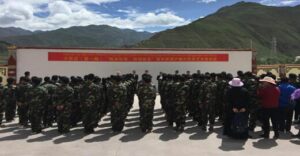
Military-style training of “rural surplus laborers” in the Chamdo region of Tibet, June 2016
Photo: Tibet’s Chamdo
A series of Chinese Communist Party(CCP) documents reveal that many thousands of Tibetans have been forced into “military-style” vocational training centres in the first seven months of this year. A compilation of these documents was released on September 22 in a report by Adrian Zenz, an advisor and researcher in The Inter-Parliamentary Alliance on China (IPAC), an alliance of legislators from eight democratic countries coordinating approaches to CCP-related issues, and published by the Jamestown Foundation for Global research and analysis. There is some confusion regarding the number of people involved, the figure has been widely reported as being over 500,000 but Contact believes the correct figure to be 54,300. According to the report, almost 50,000 of those coerced into the centres have already been transferred to work in different areas within the Tibet Autonomous Region (TAR), with the remainder sent to other locations in the country.
Forced vocational training has been carried out in the TAR before, as part of Chinese President Xi Jinping’s larger aim to eliminate statistical poverty in China by establishing measurable cash income amongst the rural population. Yet, there have been no media reports of training schemes that involve transfers of this scale and cover the entire TAR until now. According to Zenz’s report, recent CCP policies reveal that transfer quotas are now designated to all areas in the TAR by the central government. Notably, the documents also touch upon unspecified rewards and punishments that officials in charge of transfers are met with, according to their ability to meet quotas in their designated areas.
Zenz’s report identifies similarities of the training centres to those installed in [Ch: Xinjiang]* as well, and attributes these overlaps to their shared commander: Chen Quanguo. Quanguo is a former secretary of the Tibet Communist Party who also led the implementation of East Turkestan’s draconian camp system. His strategies, carried out in both East Turkestan and Tibet, include the targeted coercion of vulnerable households to supply cheap labourers. These households are identified through surveillance methods such as the grid management and the “double-linked household” systems, which were first introduced by Quanguo and the TAR government in 2012 in order to have members of communities and partnered households reporting on one another. These systems now ensure the comprehensive surveillance of the TAR’s entire population. Furthermore, Zenz reports that, like those in East Turkestan, the training centres in Tibet permeate obedience, patriotism, and anti-religious thought into the minds of labourers through “military-style” education. CCP documents describe the purpose of this education as increasing the willingness of “backwards” and “lazy” rural Tibetans to participate in working towards national “poverty alleviation.”
In reaction to this report, IPAC parliamentarians from 16 countries issued a statement calling for their governments to take “immediate action” against the CCP and their policies endangering Tibetan livelihood and societal wellbeing. Proposed actions include the imposition of sanctions on involved officials, as well as the revision of risk warnings of their countries’ businesses when using these labourers at any stage of its production and services. The parliamentarians also requested their governments to urge the CCP to lift the continued ban of international reporters into the TAR, and to allow investigations of ongoing conditions of the Tibetan people and their lives in the region.
*East Turkestan, home to the ethnic minority Uighur Muslim population, and undergoing similar oppressiveChinese rule as that experienced by Tibetans in Tibet. The forced labour camps in East Turkestan have been widely reported in the western media.




 Print
Print Email
Email